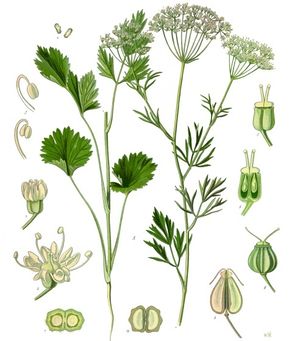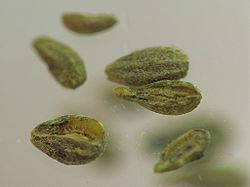Anise
| Anise | |
|---|---|

| |
| Scientific classification | |
| Kingdom: | Plantae |
| (unranked): | Angiosperms |
| (unranked): | Eudicots |
| (unranked): | Asterids |
| Order: | Apiales |
| Family: | Apiaceae |
| Genus: | Pimpinella |
| Species: | P. anisum |
| Binomial name | |
| Pimpinella anisum L. | |
Anise (Pimpinella anisum, also anís (stressed on the second syllable) and aniseed) is a flowering plant in the family Apiaceae native to the eastern Mediterranean region and Southwest Asia. It is known for its flavor, which resembles liquorice, fennel and tarragon.
Contents
Biology
Anise is an herbaceous annual plant growing to 3 ft (0.91 m) tall. The leaves at the base of the plant are simple, 0.5–2 in (1.3–5.1 cm) long and shallowly lobed, while leaves higher on the stems are feathery pinnate, divided into numerous leaves. The flowers are white, approximately 3 mm diameter, produced in dense umbels. The fruit is an oblong dry schizocarp, 3 – 5 mm long. It is these seedpods that are referred to as "aniseed".[1]
Anise is used as food by the larvae of some Lepidoptera species (butterflies and moths), including the lime-speck pug and wormwood pug.
Cultivation
Anise plants grow best in light, fertile, well drained soil. The seeds should be planted as soon as the ground warms up in spring. Because the plants have a taproot, they do not transplant well after being established, so they should be started either in their final location or transplanted while the seedlings are still small.[2]
Production
Western cuisines have long used anise as a moderately-popular herb to flavor some dishes, drinks, and candies, and so the word has come to connote both the species of herb and the licorice-like flavor. The most powerful flavor component of the essential oil of anise, anethole, is found in both anise and an unrelated spice called Star Anise. Featured prominently in South Asian, Southeast Asian, and East Asian dishes, Star Anise is considerably less expensive to produce, and has gradually displaced the 'original' anise in Western markets. While formerly produced in larger quantities, by 1999 world production of the essential oil of anise was only 8 tonnes, compared to 400 tonnes from star anise.[3]
Uses
Culinary
Anise is sweet and very aromatic, distinguished by its licorice-like flavor.[4] It is used in a wide variety of regional and ethnic confectioneries, including Greek stuffed vine leaves (Dolma), British Aniseed balls, Australian Humbugs, New Zealand Aniseed wheels, Italian pizzelle, German pfeffernusse and springerle, Netherland Muisjes, Norwegian knotts, and Peruvian Picarones. It is a key ingredient in Mexican "atole de anís" or champurrado, which is similar to hot chocolate, and taken as a digestive after meals in India.
Liquor
Anise is used to flavor the Arab Arak, the Colombian Aguardiente, the French spirits Absinthe, Anisette, and Pastis, the Greek Ouzo and Eastern European Mastika, the German Jägermeister, the Italian Sambuca, the Peruvian Anís (liqueur), and the Turkish Raki. It's believed to be one of the secret ingredients in the French liqueur Chartreuse. It is also used in some root beer such as Virgil's in the United States.
Medicinal
- Anise, like fennel, contains anethole, a phytoestrogen.[5]
- Anise is a mild antiparasitic and its leaves can be used to treat digestive problems, relieve toothache, and its essential oil to treat lice and scabies.
- Anise can be used to relieve menstrual cramps.[6]
Miscellaneous
- In aromatherapy, aniseed essential oil is used to treat colds and flu.
- According to Pliny the Elder, anise was used as a cure for sleeplessness, chewed with alexanders and a little honey in the morning to freshen the breath, and when mixed with wine as a remedy for scorpion stings (N.H. 20.72).
- In Indian cuisine, no distinction is made between anise and fennel. Therefore, the same name (saunf) is usually given to both of them. Some use the term patli (thin) saunf or velayati (foreign) saunf to distinguish anise from fennel.
- In the Middle East, water is boiled with about a tablespoon of aniseed per teacup to make a special hot tea called Yansoon.
- Builders of steam locomotives in Britain incorporated capsules of aniseed oil into white metal plain bearings, so that the distinctive smell would give warning in case of overheating.
- Aniseed is the flavour of "Black Jack" gum and Nigeria's "Tom Tom" candy.
- Anise can be made into a liquid scent and is used for both hunting and fishing. It is put on fishing lures to attract fish.[citation needed]
- Anethol, the principal component of anise oil, is a precursor that can eventually produce 2,5-dimethoxybenzaldehyde which can be used in the clandestine synthesis of psychedelic drugs such as 2C-B, 2C-I and 2,5-Dimethoxy-4-bromoamphetamine.[7]
Notes
Cite error: Invalid <references> tag;
parameter "group" is allowed only.
<references />, or <references group="..." />External links
- Anise medicinal uses, active ingredients, and additional details
- Detailed information about usage of Anise
- ↑ http://www.uni-graz.at/~katzer/engl/Pimp_ani.html
- ↑ How to Grow Anise
- ↑ Philip R. Ashurst (1999). Food Flavorings. Springer. p. 33.
- ↑ Spice Pages: Anise Seeds (Pimpinella anisum)
- ↑ Lua error in package.lua at line 80: module 'Module:Citation/CS1/Suggestions' not found.
- ↑ Muller-Schwarze, Dietland (2006). Chemical Ecology of Vertebrates. Cambridge University Press. p. 287. ISBN 978-0521363778.
- ↑ Lua error in package.lua at line 80: module 'Module:Citation/CS1/Suggestions' not found.

